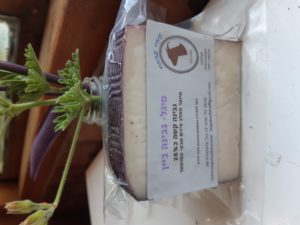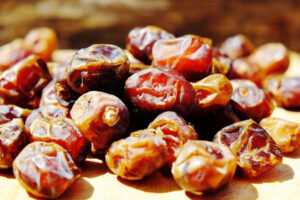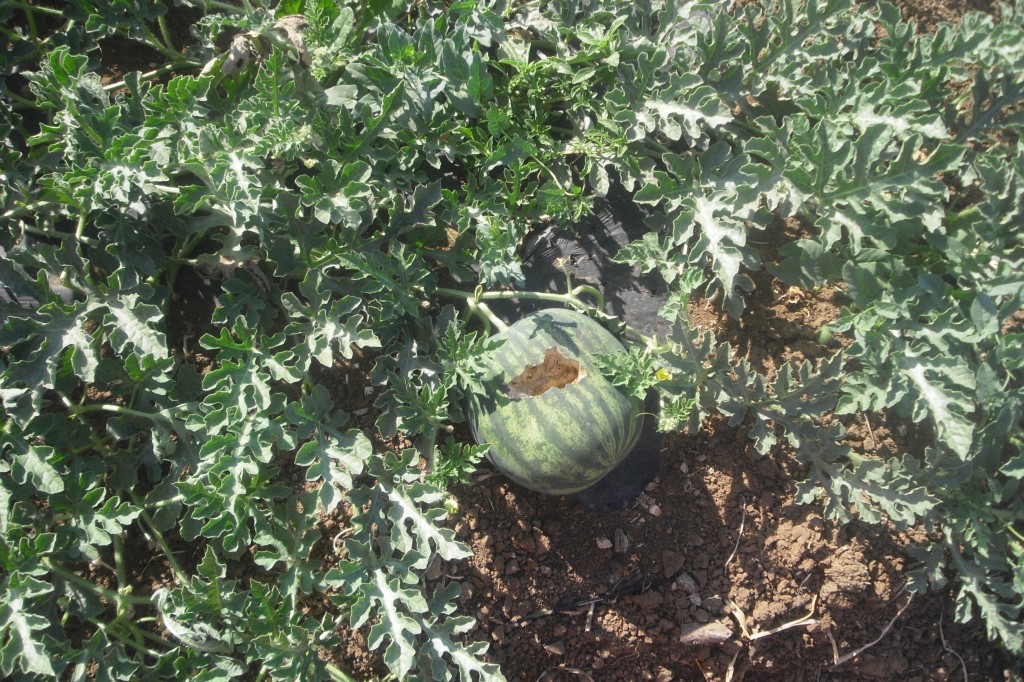 And in the spirit of seasonal renewal, the Iza Pziza dairy has added a new cheese to its outstanding assortment: Sigal Wine-Soaked Cheese, a half-hard young Pecorino-style cheese soaked in red wine and vacuum packed (26% fat).
And in the spirit of seasonal renewal, the Iza Pziza dairy has added a new cheese to its outstanding assortment: Sigal Wine-Soaked Cheese, a half-hard young Pecorino-style cheese soaked in red wine and vacuum packed (26% fat).
Price: 33.50 NIS per 150 grams
_____________________________
 To sweeten these hot days, it’s time for a super Barhi date sale:
To sweeten these hot days, it’s time for a super Barhi date sale:
For the next few weeks, enjoy absolutely delectable Barhi dates at 5 kg for just 130 NIS (reduced from 150 NIS)!
The amazing Barhi is small, sweet and ever so soft. Its caramel-like flavor inspired the growers at Kibbutz Samar to term it “Nature’s toffee.” Perfect for a healthy pick-me-up, fruit shakes, baking and of course – as is.
Bon appetite! Stay healthy!
____________________________________
 A woman once lived in a huge watermelon
With a lamp, chair and stools that set her a’kvellin’
She carved out a window, a living room too
Built a wardrobe and hung up a painting in blue
Bought a cat to catch mice – but at break of dawn
Woke up to discover the season was gone
A woman once lived in a huge watermelon
With a lamp, chair and stools that set her a’kvellin’
She carved out a window, a living room too
Built a wardrobe and hung up a painting in blue
Bought a cat to catch mice – but at break of dawn
Woke up to discover the season was gone
(Nurit Zarchi, Translated [loosely] by Aliza Raz) Illustration: Yossi Abulafia
I have a sneaking suspicion that this woman actually resided in Chubeza’s watermelon field, though it’s hard to imagine her fitting all of her belongings into our small-sized models. Yet, the feeling of the watermelon season ending so abruptly is as too familiar to us. Watermelon season at Chubeza is really short – approximately a month – so before it ends, we want to share some fascinating facts about the wonderful watermelon. This week’s Newsletter is green and red all over…
Summer officially arrived this week, and though this spring has been very gentle and (mostly) not-too-hot, we know without a doubt that the hot, heavy days are just around the corner. Yet while we moan and groan about the oppressive heat, the watermelon remains unfazed. It just loves the heat, a throwback to its origins in the southern part of the African continent, the Kalahari Desert. In the scorching desert, the watermelon, boasting a more-than-90% water content, was an important and vital source of liquid to humankind and wild animals. The difficulty in choosing a good watermelon is an old story. Even in its wild form, the sweet watermelon is identical on the outside to a bitter watermelon, necessitating the thirsty passerby to punch a hole in the watermelon rind to test its taste.
From South Africa, the watermelon spread across the African continent, and was cultivated in Egypt over 4,000 years ago. Ancient Egyptians drew depictions of watermelons to decorate sarcophagi and cave walls, and they would leave a watermelon near the dead to nourish them on their journey to the New World. The Hebrews knew it from Egypt, reminiscing, “We remember the fish, which we did eat in Egypt freely; the cucumbers, and the melons…”
From North Africa, the watermelon entered the Middle East where it grew well and was even mentioned several times in the Mishna. It arrived in China in the 10th century, and today China is the champion watermelon grower, followed closely by Turkey and Iran. In the 13th century, the Moors brought it with them to Europe, along with other plants they met in Africa and Asia. The watermelon arrived in America with the African slaves and the European settlers.
Chubeza’s love affair with watermelons began with naiveté, pretentiousness, and… failure. During my last year in California, just before I established Chubeza, I raised red, orange and yellow watermelons (the inside colors) in a farm owned by Joe Perry, my mentor. We had nice success with the yields, leading me to believe that growing watermelon would be simple, so I added watermelon to Chubeza’s nascent crop list. The first year, the watermelons simply did not grow, and we only harvested a few dozen from our fancy beds. Fortunately, back in 2004, our entire clientele also numbered a few dozen, so they received the watermelons as planned (which, admittedly, weren’t too sweet). One of the main reasons for this failure was the timing. I seeded watermelons like we did in California, at the end of spring. Yet springtime in Israel is fraught with viruses and disease, particularly among the cucurbit family to which our watermelon friend belongs.
After taking a hiatus of several years, chalking up experience with cucurbits and their viruses, we decided to try again, this time calibrated to precede the viruses. Thus, nine years ago we made a second watermelon attempt. This time we seeded earlier, resulting in a larger yield. A year later we did even better, and seven years ago we dared to plant seedless watermelon varieties. This sort of watermelon-growing is more complex than raising a standard seed-filled watermelon, for we are essentially trying to buck nature. The mission of every fruit and vegetable is to reproduce and generate offspring (seeds). Wo/man, meanwhile, is bent on getting rid of the watermelon seeds, and not by spitting them out. Modern-day human beings had grown weary of seeded fruits and set out to develop seedless varieties. Actually, a seedless watermelon does contain some tiny seeds, however most are transparent as well as infertile. You must admit this is strange, to try to develop a fruit which cannot produce seeds or offspring. On one hand, a vast scientific effort is being placed upon refining and improving human fertilization via IVF, freezing embryos and sperm, surrogates, etc., while simultaneously we are encouraging sterility in fruits.
So how do these “seedless” watermelons grow year after year? Regular watermelon seeds are diploid seeds, i.e., containing two sets of X chromosomes. Those used in order to produce seedless watermelons are tetraploid, possessing four sets of X chromosomes. Seedless watermelon seeds have a harder than average shell, which is why it is more difficult to grow the melons from seeds. In most cases, they are planted as transplants that were started in the nursery under controlled conditions. The tetraploid seeds sprout and become plants that will generate leaves and flowers but no fruit, unless they’re fertilized from flowers of a regular seeded watermelon. Therefore, you must plant one row of regular watermelons for every three to four rows of seedless ones. During pollination, each seed contributes half of its chromosomes: 1+2, resulting in a fruit whose seeds are tetraploid, possessing three sets of chromosomes. This uneven number disrupts the seed’s ability to reproduce, and ultimately sterilizes it. Thus, we receive a fruit which is juicy and sturdier than its seeded friends, but it evolved from the “virgin birth” of an unfertilized cell. It’s called a “Parthenocarpic fruit,” in essence, the mule of the botanical world…
Human beings are not alone in adoring the watermelon, which is also loved by animals and, of course, birds. More specifically, intrepid sweet-toothed hard-beaked blackbirds. We protect our fruits with a passion, otherwise, we find them looking like this:
Which is when we cover the bed with a bird’s net preventing the blackbirds from feasting on this red, juicy delight. And this year we are going for double protection – with nets on the bottom and a tireless bird scarecrow hovering above.
For those who might have might have missed it:
Basically, it is a kite shaped like a big vulture, fastened on a flexible 6-meter telescopic pole. This kite soars with even the gentlest breeze, flying in a manner that imitates the flight of birds of prey. Its random, varying aviation patterns prevent the harmful birds from getting accustomed to it. Which is why they continue to keep their distance: It looks too close to the real vulture (even fools us sometimes…) Don’t take our word for it, go ahead and judge for yourselves. Here it is:
Watermelon is a healing fruit. Its ample water content cleanses the body, making watermelon juice frequently recommended for those suffering from bladder and liver deficiencies. It is also beneficial for cleansing the kidneys. Watermelon even helps to clean the body of cigarette smoke – highly recommended for active and passive smokers alike.
Traditional Yemenite folk cures use watermelon seeds to rid bad breath and stains from the teeth and mouth. Crush the seeds well, immerse them in water, and then strain for a super mouthwash. In Iraq, watermelon rind is used to treat fungal infections. Libyan Jews are known to rub their skin with watermelon rind to lighten age spots. Watermelon contains vitamin A in the form of carotenoid, vitamin C, and vitamins from the B group as well (B1 and B2). It is low in nitrogen and high in potassium. Further information about the nutritional and therapeutic virtues of our round, red, delicious friend can be found here (Hebrew).
So… how does one select a ripe, sweet watermelon?
– We pick the watermelon at its ripest, when the tendril near the stem dries up. Therefore, when choosing a watermelon at the stand, look for the drier and slightly withered stem, indicating that the watermelon wasn’t picked while green.
– The part that comes in contact with the ground changes its color to yellow, so you should look for a yellow (not white) spot on one of the watermelon sides.
– And the most mysterious signal of all: if you tap on the fruit, you will hear a dim echo reverberating back to you.
Check out this live demonstration
How to store a watermelon:
The best temperature to store a watermelon is 12°C, but even at room temperature (23°) the watermelon will keep for a week to 10 days. Don’t overdo it, though. A watermelon stored for too long will lose its taste and change its texture.
It is not recommended to freeze a watermelon or store it in the cooler compartments of your fridge. Overexposure to cold can cause frostbite, taking a toll on the watermelon’s flavor and making the inside soft and powdery. To store it after slicing open, wrap in plastic wrap and store at a temperature of 3-4°.
And once you have that excellent watermelon, slice it, add mint and feta cheese, and sit back and enjoy this spectacular summer treat, while reading a collection of surprising, interesting and humorous facts about watermelons (Hebrew)
Check out our recipe section for interesting things to do with watermelon, if any is left after slicing into cubes and devoured on the spot.
Enjoy!
Alon, Bat Ami, Dror, Orin, and the Summertime Chubeza Team
________________________________________
WHAT’S IN THIS WEEK’S BOXES?
Monday: Zucchini, butternut squash/acorn squash, melon/watermelon, cucumbers, tomatoes, Amoro pumpkin/slice of pumpkin, corn, parsley/coriander, string beans, New Zealand spinach/Swiss chard. Small boxes only: cherry tomatoes.
Large box, in addition: Scallions/leeks/garlic, eggplant/potatoes, beets/ fakus, lettuce.
FRUIT BOXES: Apples, bananas, nectarines. Small box, Also: Cherries. Large box, Also: Flat peaches
Wednesday: Zucchini, melon/watermelon, cucumbers, tomatoes, Amoro pumpkin/slice of pumpkin, corn, parsley/coriander, string beans, New Zealand spinach/Swiss chard, eggplant/fakus, lettuce.
Large box, in addition: Scallions/leeks/onions, beets/butternut squash/acorn squash, cherry tomatoes..
FRUIT BOXES: Apples/cherries, bananas, nectarines, grapes

